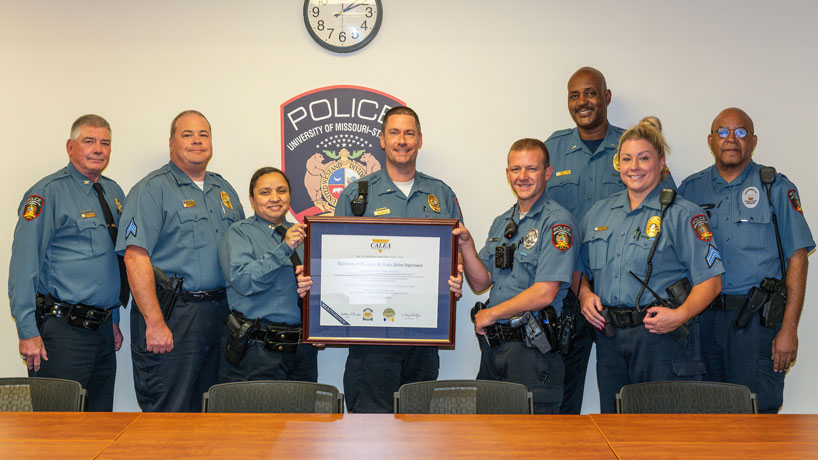
UMSL Police Lt. David Woods (center) holds an enhanced Certificate of Meritorious Accreditation from the Commission on Accreditation for Law Enforcement Agencies. This most recent certificate makes it the eighth time the department has been accredited by the organization since 2000. (Photo by Derik Holtmann)
University of Missouri–St. Louis Police Chief Dan Freet gestures to his computer screen, which showcases a law enforcement web platform. He clicks on a drop-down menu in a section about the pursuit of motor vehicles, and a veritable wall of text unfurls.
“You need to have all of this,” Freet said, pointing line by line to all standards required for a proper pursuit.
The software tool is one of the ways the UMSL Police Department has maintained its exemplary public safety track record over the years and how it stays apprised of the most up-to-date public safety standards set by the Commission on Accreditation for Law Enforcement Agencies.
The department recently received an enhanced Certificate of Meritorious Accreditation from CALEA for its continued dedication to those standards. This most recent certificate makes it the eighth time the department has been accredited by the organization since 2000.
“It keeps everybody accountable,” Freet said of CALEA standards. “It keeps the information flowing, and you’ve got the best police practice that’s out there. I think that’s a good thing. I think that helps students and parents feel safe.”
CALEA was created in 1979 as a credentialing authority through the joint efforts of law enforcement’s major executive associations International Association of Chiefs of Police, National Organization of Black Law Enforcement Executives, National Sheriffs’ Association and Police Executive Research Forum. The agency is considered the gold standard of law enforcement.
“They all came together and said, ‘Look, if we were going to make a police department run the way it’s supposed to and provide good professional service to people so that the citizens know that they’re getting the best, both in policy and in complying with that policy, here’s how we’d start doing it,’” Freet explained. “They just broke it down into sections. Some of it is as high-profile as when to squeeze the trigger on a weapon. Some of it is as low-profile as, is your filing system in good order for your paperwork?”
Freet credits former UMSL Police Chief Bob Roeseler for initially seeing the need for CALEA standards. Under Roeseler and former Chancellor Blanche Touhill’s direction, the department began a three-year assessment process to receive accreditation in 1997. At that time, UMSL became only the 18th university in the country, and the fifth land-grant institution, to have its police department accredited by the organization.
It turned out to be a forward-thinking decision. Freet said when UMSL was first accredited in 2000, there wasn’t much public demand for it. However, demand has increased in recent years, particularly in the wake of the killing of George Floyd in Minneapolis.
“Nobody wants to see something like that happen,” Freet said. “So generally speaking, you’ll hear more of a public outcry for accreditation after something like that happens. It’s a shame that it has to come to that. So, actually we were well ahead of the bell curve.”
Freet noted that becoming accredited initially is a lot of work. However, he saw the benefits of it coming from another CALEA-accredited agency, the St. Louis County Police. He added that it’s much easier to stay in line after earning the initial certificate.
To be a CALEA member, departments must use the organization’s digital software. CALEA uploads all of its standards to the tool, and in turn, departments can upload their polices to the same platform to make sure they are in sync.
CALEA’s accreditation team works in four-year cycles, and during that time, the team reviews a portion of the department’s policies for two key elements. First, the team makes sure the department’s standards require the same things as CALEA. Second, the team solicits documents proving the department is adhering to those policies.
Freet pointed to use of force policies as an example.
“One of their policies is no officer that works for a CALEA-accredited agency can carry a weapon until they’ve proven proficiency with it,” he explained. “Let’s say I hire a guy who walks in the door here, and he’s been a cop for 40 years. Of course, he knows how to use his weapons. But before I give him the UMSL uniform, he has to go out to the range and shoot the targets. He has to take the training on the nightstick and then the training on the pepper spray to show proficiency. Then, we provide our onboarding process or those qualifications, where we go out and score with scorecards, and we load all that back into that same platform.”
CALEA also performs on-site visits and reviews annual reports on areas such as vehicle pursuits and use of force. Lt. David Woods serves as the department’s compliance officer, but buy-in from the whole department has made his job much easier.
“It’s a team effort,” Woods said. “I’m the one who takes stuff and loads it in and looks for it and highlights it, but I couldn’t actually do that if I didn’t have everyone on board.”
Freet said continuing to maintain an outstanding public safety record, partially through adherence to CALEA standards, gives the UMSL community peace of mind.
“We’re quietly going about our business helping students get their degree, but if you’re sending your child here to go to school, don’t you want to know that the police department’s using best practice?” he said. “Of course, you do.”
The department’s standards bring him peace of mind, as well.
“I don’t worry sitting at home at night about whether our policies are good or not, and that’s my job – to make sure we’ve got good policy,” he said. “I’m not worried because I follow CALEA to the tee.”














